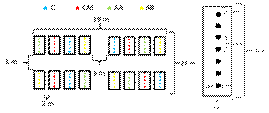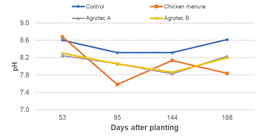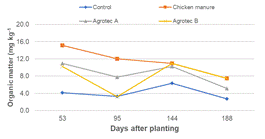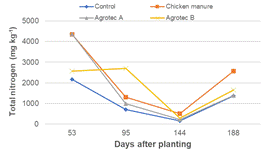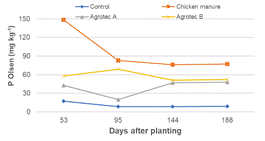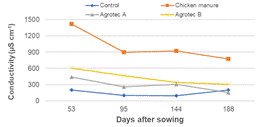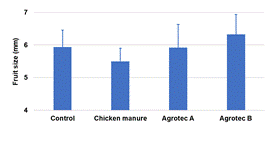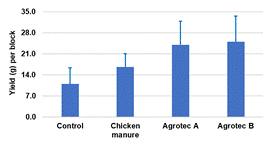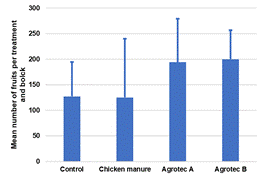INTRODUCTION
Agriculture plus food chain service accounts for 11.3% of gross domestic product (GDP) of Perú (BID, 2021). This sectors is growing fast, reaching 7500 million USD in exportation in 2020, becoming Perú the highest exporter of blueberry, overcoming 1000 million USD and ~15000 has of blueberry crop (AGN, 2020).
Perú´s weather let to grow high productive varieties such as Biloxi (most extended in the country). However, majority of crop lands are at Peru´s coast, where soil properties are no adequate for this crop. Blueberry plants required acid soils (pH between 4.5-6), and high content of organic matter (15-20 g kg-1). In this sense, it is needed a soil correction management to adequate them to blueberry crop.
Nowadays, farmers are cropping in big pots filled with organic matter (mix of husk and bark), buying top-soil from the mountains, transport peat from north of Europe or use manure to fulfil the organic matter requirements of blueberry crop. For instance, chicken manure is the most demanded one due to the high fertilization properties but its price is more expensive.
Therefore, the objective of Inproyen was to develop organo-mineral substrates from different wastes to fulfil blueberry organic matter and other soil parameters requirements.
MATERIAL AND METHODS
Experimental design
Study field occupied 975 m2 disposed in four blocks with four treatments in each one (Figure 1). Each treatment contain seven plants of blueberry (Vaccinium corymbosum var. Biloxi).
Waste identification and characterization
Samples from 19 companies were taken to be physically and chemically analyzed. These companies are located in three different Peru´s departments (La Libertad, Lambayeque and Piura) surrounding the experimental area (Trujillo).
Design and implementation of substrats
It was made a theoric design of different proportions of wastes to synthesize two different organo-mineral substrates for blueberry. Once formulas were done, the next steps of the process were waste storing, mix and homogenization and maduration. Thus, it was get the two organo-mineral substrates, Agrotec 1 (AA) and Agrotec 2 (AB), that together with the Chicken manure (bought) and Control (no application) comprise the four treatments. All were analyzed phycallly and chemically (Table 1) before applying them in a trench -9 × 0.5 × 0.35 m- as base dressing with a rate of 40 tons per ha.
Table 1 Physico-chemical properties of four treatments
| ID | pH | EC | OM | N | P | K |
| Units | μS cm-1 | mg kg-1 | ||||
| C | 8.8 | 146 | 1.3 | 404 | 981 | 852 |
| CM | 9.5 | 8090 | 284 | 8313 | 12900 | 15650 |
| AA | 7.2 | 5130 | 455 | 2100 | 3329 | 17060 |
| AB | 7.7 | 7973 | 435 | 3330 | 3963 | 15135 |
EC: electrical conductivity; OM: organic matter; N,P and K: Total nitrogen, phosphorus and potassium
Blueberry plants and irrigation
Blueberry plants were buying in a nursery and planting in each ridge, being watered with ~2.3 L/day/plant through the installed drip irrigation system.
Soil and plant monitoring
Soil parameters and plant physiology were analyzed during 9 months. It was done four soil samplings to analyze parameters such as pH, Electrical Conductivity (EC) , Organic matter (OM), Cation Exchange Capacity (CEC), avaible micronutrients, among others. Plant physiology samplings were done in leaves and fruits, analysing either number, size (23 samplings), as well as elemental composition (two samplings).
RESULTS
Soil evolution
Figure 2 shows pH evolution for four treatments. The decrease of pH was higher but irregular with CM treatment. The soil OM under different substrate treatments is very similar 188 days after planting (DAP) -Control excepted-, even though Chicken Manure treatment showed a big difference respect to others 53 DAP (Figure 3).
Total N in soil rapidly decreases in all treatments showing a rare increase 188 DAS discussed in next section (Figure 4).
The available phosphorus in soil (P Olsen) was very high with all treatments, highlighting the high strong decrease suffered by Chicken Manure treatment from 53 to 95 DAP (Figure 5).
One of the parameters that should be taking into account when manure is applied is the EC because it used to be high and can cause crop yield losses. Soil under CM treatment showed values of 1500 µS cm-1 54 DAP that decreased to 900 µS cm-1 188 DAP; whilst Agrotec A and B went from 600 to 500 µS cm-1 (Figure 6).
Crop performance
Blueberry was producing fruits during more than two months. These berries showed the highest size with Agrotec B and the lowest with Chicken manure (Figure 7). Even though plants were very small and the production was low, there were notable differences between treatments relative to blueberry yield (Figure 8). Agrotec B showed the best yield followed by Agrotec A, being 100 and 44% higher than CM treatment. This differences are related with the number of fruits produced wich followed same tren as yield (Figure 9).
DISCUSSION
Soil properties are seemingly better when chicken manure is applied, but this results did not correspond with the plant performance. The main explanation is the lack of stabilization of the Chicken manure substrate and its organic matter, mainly. This substrate quickly increases the soil OM content, as well as the amount of other nutrients, which cannot be absorbed by the plant as quick as they are delivered. However, Agrotec A and B, although did not fulfil pH value as expected, they showed a balanced behaviour along the experiment. This study can claim that “more is not always better” and a gradually nutrient delivery could be better for plant performance as it was shown here. Size of berries is one of the most valuable properties in blueberry crops. So, this parameter together with the increase in yield and number of fruits by Agrotec supports the need of a stabilization process of labil organic matter before applying into the field but also the use of more sustainable organic matter sources. Thus, waste recovery is a better alternative to adjust soil properties for blueberry crop due to decrease the waste produced, practice a circular economy and enhance soil properties and consequently the crop.
CONCLUSION
Create substrates from waste recovery for blueberry crop is possible. Besides, a correct design of Agrotec let fulfil the most important soil and plant requirements and as it was shown with CM treatment “More, is not always better”. Finally, it can be claimed that a stabilized substrate such as Agrotec A and B enhance the performance of blueberry crop, specially Agrotec B.













